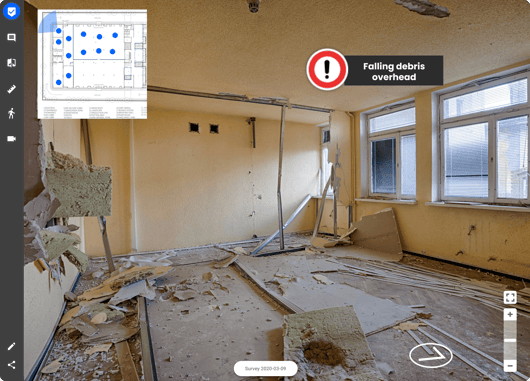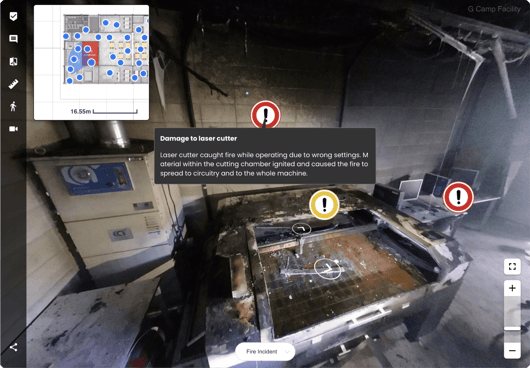According to the IMARC Group, the global digital twin market is valued at USD 10.3 Billion in 2021 and will continue to grow at a CAGR of 31.7% until it reaches a value of USD 54.6 Billion by 2027. That's more than five times the original size of the market!
Rightly so as companies stand to benefit from digital twin solutions in terms of increasing product quality, achieving efficiencies in cost, time, and resources, and improving collaboration and workflows across departments and organizations. And when it comes to the common use cases for digital twins, most will mention it alongside IoT systems, BIM solutions for construction, manufacturing, smart cities, and even healthcare.
In this article, however, we want to focus on some use cases that don’t get much attention but have the potential to be game-changers for each industry.
1. Demolition
First, people often associate digital twins with an actual product. But the concept of digital twins is also being applied to the built environment. And the benefits follow the same lines of quality improvement, cost and risk reduction, time savings, and collaboration synergy.
Second, it is true that buildings are often mentioned as a use case for digital twins, and it is usually in the context of construction projects, building operations and maintenance, or marketing for real estate. But digital twins are actually powerful tools for the entire built environment lifecycle: from conducting land surveys, to progress monitoring during construction, to managing building operations and maintenance, until the demolition and redevelopment phase, which we will focus on in this article.
Demolishing a building is more complicated than you might think. It took careful planning for a building to be constructed, and even then accidents happen. It’s the same for the demolition process, except here, you’re dealing with explosives, or, in some cases, 12,000-pound wrecking balls. This process involves more than just wrecking stuff, like inspecting the site, studying its materials and structures, placing safety measures for workers, and creating a detailed demolition plan. These activities can be facilitated and documented through digital twins.
Digital twins allow remote site inspections by demolition experts, facilitate smooth collaboration, and advocate worksite safety. Digital twins also allow teams to monitor the progress of the demolition project, just like any construction project: from the initial site survey to the removal of hazardous and dangerous materials, non-load-bearing walls, windows, doors, and fixtures, until the actual demolition.

2. Education, training, and safety
Next, we’re talking about using digital twins to enhance workplace safety. We always hear it applied to construction, but for this article, we’re focusing on the logistics and distribution industry. Yes, you’ve read that right. This may be surprising to most, but logistic warehouses attract a lot of accidents. Warehouse employees often lift heavy objects and work graveyard shifts. This poses problems for workers who need to stay alert at all times, especially when dealing with heavy and bulky equipment. An employee can drive a forklift truck and suddenly bump into a shelf and cause a cascade of damage, possibly resulting in injury and even death.
Digital twins can be an effective solution to promote safety and manage risks and hazards. Safety protocols, manuals, and training videos can be uploaded into a digital twin of the warehouse, placed conveniently where one can expect the information to be. This provides workers with context associated with the safety materials, easily accessible whenever they need it. With an injury prevention program in place, companies can reduce incidents by up to 60%, according to OSHA.
In addition, digital twins and sensor technology can be used to constantly and remotely monitor warehouses in place of periodic site inspections to ensure that protocols and regulations are being followed. In the construction industry, AI solutions are already being developed to identify and preemptively manage risks and hazards. It’s only a matter of time before these solutions can be applied to other industries like warehousing.
3. Insurance
When it comes to Insurance, there are two main areas where digital twins can play a critical role: underwriting and claims.
First, assessing a property, whether commercial or residential, requires insurance underwriters who visit the property to assess its features such as the construction and condition of its buildings and facilities, geographical location, topography, road infrastructure, neighboring properties, etc. Without visiting onsite and doing a thorough survey of the assets, it’s hard to estimate replacement costs that represent the appropriate amount of coverage needed.
With digital twins, you can create a high-fidelity virtual replica of the building and its surroundings and share that with all involved stakeholders like the owners, underwriters, and insurance carriers. AI solutions can be applied to scan for features that might contribute to risk exposure, like water or network towers, powerlines, swimming pools, cracked sidewalks, tree overhangs, etc. Overall, having digital twins will allow a more accurate and transparent assessment of the property that can benefit both parties.
For claiming damages in the event of fires, explosions, theft, storms, or other natural disasters, digital twins can be used by both the insured and insurer to document the extent, repairment or replacement requirements, and actual value of the damages. A professional claims adjuster can easily conduct an inspection of the damaged property by going through the digital twin in detail without ever having to travel to the location. A digital twin of the property even before the incident has occurred can also serve as a basis to account for all the physical assets located at the property and their conditions.

4. Crime scene investigation
The last use case that isn’t talked about as much, but would certainly benefit from digital twins, is crime scene investigation. Let’s think about what the workflow normally looks like. When police and investigators arrive at a crime scene, they have to conduct an initial survey of the location and take photographs of everything that seems like it can be probative evidence. After documentation and collection of various kinds of physical evidence, data about each piece of evidence must be logged into an inventory, matched to a crime scene report, and attached with the appropriate photo documentation.
Capturing a crime scene by creating a digital twin can make surveys faster, more accurate, and more useful. Police will be able to preserve the scene exactly the way it was, use the twin for convenient and future reference, share it with the forensics team, and present it in court. Each piece of evidence can be tagged in the appropriate location where it was found in the digital twin to provide investigators with spatial context. Investigators can upload detailed photos or videos, the resulting laboratory reports, or comments for teammates right into the digital twin. Think sticky notes but on steroids!
To encourage transparency and accountability, police can also create multiple digital twins at different points in time to check if anything on site has been tampered with during the course of the investigation.
Conclusion
Today, the number of companies using digital twins continues to grow, whether it’s for remote site inspections, surveillance, or simulations. But digital twins have the potential to grow beyond that and transform industries beyond just AEC, manufacturing, or energy and utilities. With this article, we hoped it inspired you to get creative with how digital twins can serve your company and industry in new and innovative ways.